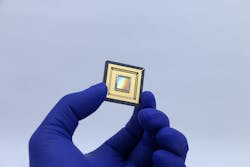'Sticker' approach simplifies light manipulation for pathogen detection
To improve detection of pathogens such as HIV and viruses that cause respiratory tract infection, which have molecular fingerprints that are difficult to distinguish, sensors in diagnostic tools need to manipulate light on a nanoscale. However, a method to manufacture these light manipulation devices without damaging the sensors does not yet exist.
Recognizing this, a team of researchers at Purdue University (West Lafayette, IN) has integrated light manipulation devices called 3D plasmonic nanoarrays onto peelable films that can stick to any surface. They tested the sticker-nanoarray's capabilities on the lenses of sensors, which make up conventional imaging systems. The Air Force Research Laboratory, which supported the work, helped to validate the sticker's performance and properties.
“Unlike any existing approaches, the entire process occurs in distilled water at room temperature without the chemical, thermal, or mechanical treatments that can damage sensitive surfaces, such as a sensor lens," says Chi Hwan Lee, an assistant professor of biomedical engineering and mechanical engineering at Purdue University.
To turn the nanoarrays into a sticker, the researchers built them into a film on a silicon wafer. When submerged in distilled water, the film peels cleanly from the wafer, allowing the wafer to be reused. The film can then stick to the desired surface without damaging it.
"Because this methodology allows 3D plasmonic nanoarrays to physically separate from a donor wafer and transfer over to another surface without defect, it offers a major cost- and time-saving factor in the manufacturing scheme," Lee says.
The researchers also demonstrated that the process works for various classes of 3D plasmonic nanoarrays in both lateral and vertical configurations, offering more functionality.
Lee's lab plans to further develop these sticker-nanoarrays for biosensing applications, such as for protein detection in clinical diagnostics. The lab has already created electronic stickers that serve as biopatches for drug delivery. They also can enable ordinary objects to wirelessly connect to a network, creating an Internet of Things (IoT).
The method has been patented via the Purdue Research Foundation Office of Technology Commercialization.
Full details of the work appear in the journal Nano Letters.
